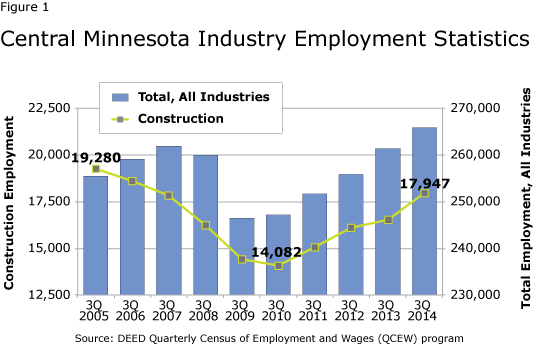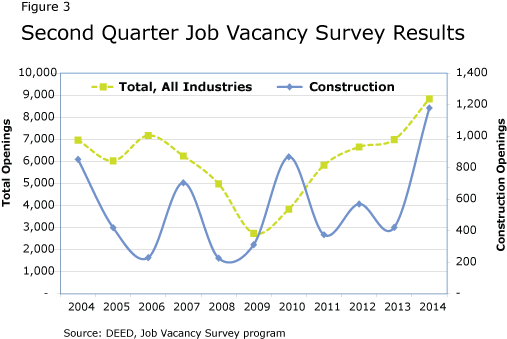by Luke Greiner
May 2015
Historical employment data show how predictive the construction industry was of the last economic downturn. Starting in 2006, it was one of the first industries to show signs of the looming "Great Recession" that ravaged the state and region from December 2007 to June 2009.
Construction industry employment started sinking sooner, plummeted faster, and recovered later than the total of all industries. Historical data from DEED's Quarterly Census of Employment and Wages (QCEW) program show Construction suffered year-over-year job cuts from the third quarter of 2005 to the third quarter of 2010, experiencing a total loss of nearly 5,200 jobs or more than 25 percent of the previous peak employment level set in 2005 (see Figure 1).

Since then, the construction industry has been adding jobs at a rapid pace, regaining almost 4,000 jobs from the third quarter of 2010 to the third quarter of 2014. If that pace continues, the construction industry should surpass its prerecession peak by the third quarter of 2015.
Construction employers in Central Minnesota added more jobs than any other industry over the past year, outpacing even Health Care and Manufacturing. The region gained just over 1,400 net new jobs, an 8.5 percent increase, compared to a 1.7 percent increase across all industries combined.
That pushed Central Minnesota to the forefront in the state, both in construction employment and total employment growth. Figure 2 shows employment changes in each of the Minnesota planning regions from the end of the recession in 2009 to the most recent data available in 2014.

The construction industry clearly benefits from the expanding economy in the state and region. As businesses grow, they require additional facilities to be built or developed further, more jobs mean that more workers have more money for new houses and remodeling, and increased tax collections allow for new funding of infrastructure projects.
The construction industry is divided into three main subsectors, each with its own specialty. Although it has some of the smallest employers, the largest sector is specialty trade contractors, with just over 8,200 employees at nearly 1,800 firms, an average of less than 5 employees at each firm. The next largest sector is heavy and civil engineering construction, which has 4,176 jobs at 203 larger employers - an average of more than 20 employees per site. The smallest sector is construction of buildings, which has 2,756 jobs at 635 firms (see Table 1).
| Central Minnesota Construction Subsector Industry Statistics, Average of Quarters 1-3 2014 | |||||
|---|---|---|---|---|---|
| Industry/Subsector | Number of Firms | Number of Jobs | Share of Construction Jobs | Number | Percent |
| Construction | 2,636 | 15,140 | 100% | 1,134 | 8.1% |
| Construction of Buildings | 635 | 2,756 | 18% | 241 | 9.6% |
| Heavy and Civil Engineering
Construction |
203 | 4,176 | 28% | 344 | 9.0% |
| Specialty Trade Contractors | 1,799 | 8,207 | 54% | 549 | 7.2% |
| Source: DEED, QCEW | |||||
Construction of buildings includes both residential and nonresidential construction. While residential building construction maintains slightly more jobs than the commercial and industrial building side, it is the latter that has enjoyed more growth in the last few years in Central Minnesota. Average annual wages for the construction of buildings sector was $42,614, which was 11.3 percent higher than the average for all jobs in Central Minnesota.
Because of the obvious implications of the housing crisis that helped trigger the recession, this subsector experienced the largest declines moving through the recession and recovery, losing over 39 percent of its jobs from 2006 to 2010. Since 2010, however, this subsector has managed to increase employment by 38.5 percent, regaining almost 750 jobs through the first three quarters of 2014.
Wages were particularly high in the heavy and civil engineering construction subsector with an average annual wage of just over $74,555. That's 75% higher than the average wage for all jobs in Central Minnesota. Thanks to an increase in highway, street, and bridge construction, utility system construction, and land subdivision projects in the region, this subsector accounted for 46 percent of job growth in the construction industry in the last year.
The heavy and civil engineering construction sector also withstood the recession much better than the construction of buildings and specialty trade contractors sectors. Average annual employment dipped just 7.5 percent from 2006 to the employment low in 2009, losing 260 jobs. Since the low in 2009, the heavy and civil engineering construction sector added nearly 1,000 jobs (30%) through the first three quarters of 2014 and now has about 700 more jobs than the annual average before the recession.
Specialty trade contractors includes 29 different classifications of contractors, covering everything from framing, roofing, and siding contractors to electrical, plumbing, heating and air-conditioning contractors. Specialty trade contractors experienced similar employment trends to the construction of buildings sector through the recession and recovery.
Despite the recent gains, employment is still down by almost 20 percent for both housing-related industry sectors, leaving considerable room for sustained growth. Average annual wages are estimated at $44,798. for specialty trade contractors, about $7,000 more than the average wage for all industries.
These higher wages are a highlight of the industry. Of the 31 occupational titles classified in construction and extraction occupations, over three-quarters have a higher median wage than the median for all occupations in Central Minnesota.
Even at the entry level, construction jobs provide higher wages than other occupational groups. For example, wages at the 10th percentile were higher in all but one construction occupation, helpers of pipelayers, plumbers, pipefitters, and steamfitters. The wage advantage dissipates somewhat at the top of the pay scale, with only about one-third of the occupations having higher 90th percentile wages than the total of all occupations (see Table 2).
| Central Minnesota Wage Statistics for Construction Occupations | ||||
|---|---|---|---|---|
| Occupational Title | Employment | Annual Wage | ||
| 10th Percentile | Median | 90th Percentile | ||
| Total, All Occupations | 258,710 | $18,264 | $33,853 | $72,134 |
| First-Line Supervisors of Construction Trades Workers | 670 | $45,304 | $62,770 | $89,726 |
| Brickmasons and Blockmasons | 160 | $39,957 | $54,336 | $84,304 |
| Carpenters | 1,860 | $31,455 | $43,212 | $67,610 |
| Carpet Installers | * | $41,867 | $52,942 | $60,376 |
| Tile and Marble Setters | * | $39,379 | $44,299 | $53,211 |
| Cement Masons and Concrete Finishers | 430 | $34,643 | $55,825 | $72,993 |
| Terrazzo Workers and Finishers | * | $25,155 | $28,929 | $52,048 |
| Construction Laborers | 960 | $26,084 | $36,520 | $62,371 |
| Paving, Surfacing, and Tamping Equipment Operators | 270 | $32,700 | $40,085 | $51,923 |
| Operating Engineers and Const. Equipment Operators | 1,400 | $34,118 | $47,801 | $68,057 |
| Drywall and Ceiling Tile Installers | 20 | $38,842 | $54,529 | $60,660 |
| Tapers | * | $19,220 | $32,749 | $65,082 |
| Electricians | 1,250 | $32,719 | $52,045 | $76,140 |
| Glaziers | * | $25,338 | $28,134 | $30,990 |
| Insulation Workers, Floor, Ceiling, and Wall | * | $26,759 | $81,759 | $92,938 |
| Insulation Workers, Mechanical | 170 | $31,372 | $63,119 | $88,754 |
| Painters, Construction and Maintenance | 200 | $24,567 | $34,163 | $55,982 |
| Pipelayers | 150 | $37,024 | $53,120 | $74,254 |
| Plumbers, Pipefitters, and Steamfitters | 1,020 | $28,482 | $53,000 | $75,268 |
| Roofers | 260 | $29,608 | $50,885 | $59,982 |
| Sheet Metal Workers | 390 | $29,792 | $46,925 | $69,735 |
| Structural Iron and Steel Workers | 40 | $32,538 | $38,185 | $72,516 |
| Helpers, Brickmasons, Blockmasons, Stonemasons | 140 | $22,566 | $27,956 | $63,003 |
| Helpers, Carpenters | 90 | $20,320 | $25,018 | $30,663 |
| Helpers, Pipelayers, Plumbers, Pipefitters, and Steamfitters | 60 | $16,261 | $19,421 | $39,937 |
| Construction and Building Inspectors | 120 | $34,090 | $52,458 | $80,275 |
| Highway Maintenance Workers | 750 | $32,320 | $43,007 | $52,390 |
| Septic Tank Servicers and Sewer Pipe Cleaners | 60 | $26,112 | $34,014 | $67,032 |
| Construction and Related Workers, All Other | 60 | $21,100 | $26,733 | $40,705 |
| Earth Drillers, Except Oil and Gas | * | $20,760 | $35,215 | $68,208 |
| Helpers--Extraction Workers | * | $28,597 | $41,952 | $68,603 |
| * Data are suppressed | ||||
| Source: DEED, Occupational Employment Statistics (OES) program | ||||
Job vacancy data can serve as a leading indicator for the direction of an industry because staffing patterns are driven directly by both new and pent-up demand. According to DEED's second quarter 2014 Job Vacancy Survey, job openings in Construction more than doubled from the previous year. It was the highest number of second quarter job vacancies ever reported by employers (see Figure 3).

The expansion of the construction industry and the increase in job vacancies is especially good news for youth in Central Minnesota. Just prior to the recession over 18 percent of construction industry jobs were held by young people from 14 to 24 years of age. As the industry laid off workers, the share of jobs filled by the youngest age cohort bottomed out in 2011 at 9.7 percent and still stands at a much lower 11.3 percent. Currently about 1,549 jobs are held by workers in this age cohort, which is 1,123 fewer jobs than prior to the recession.
An increase in employment for youth in construction not only tackles this age group's higher unemployment rate, but also provides a chance to earn more money. The youngest construction workers earn well over 50 percent more than the average for their peers in all industries.
According to DEED's Cost of Living Calculator, a young adult with no children would need to earn a minimum of $24,504 per year to meet a basic cost of living budget in Central Minnesota. Young adults without children in the 22 to 24 year-old age group who work in Construction earn an average annual wage that is roughly $4,000 above that basic needs budget.
While apprenticeships and formal education provide a clear path to construction occupations, the industry also presents those with a high school diploma or less a wide array of options to gain meaningful employment in the fourth highest paying industry in Central Minnesota. With plenty of room for expansion, a variety of jobs with great wages, and a bright employment outlook, the construction industry should continue to help Central Minnesota's economy keep hammering away.
† Annual Wage was computed using the four most recent available quarters.